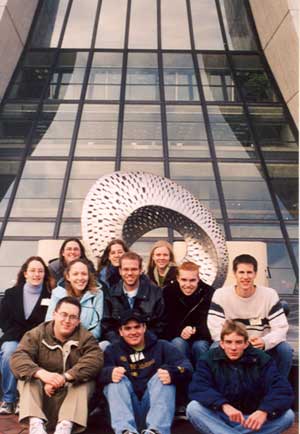The (New) Editor's Corner
By Dwight E. Neuenschwander, Editor

Credit: Photo by D.E. Neuenschwander
The author's students in front of a Robert Wilson Sculpture, Wilson Hall, Fermilab, 2003.
As your new editor of the FHP Newsletter, I find myself surrounded by people who have a passion for the history of physics and are authentic experts. My own attempts at physics historical scholarship are modest by comparison, but those experiences have taught me how difficult it can be to get it right—and how rewarding it is to try. Therefore I appreciate the difficulties, depth, and value of the work done by historians of physics. It is an honor to be associated with the Forum on History of Physics.
Your previous editor Michael Riordan, and his predecessors Benjamin Bederson, William Evenson, William A. Blanpied, Albert Wattenberg, and Stephen G. Brush have set high standards indeed. I therefore am glad Michael Riordan saw fit to remain through this issue as Associate Editor, to help me learn my way around.
When I decided to major in physics, I knew the ride would be interesting. But I had little idea how wide the perspective would be. Physics is not just about black holes and Lagrangians - it's a community that cuts across cultures and centuries. Having for our intellectual companions the likes of Albert Einstein and Emmy Noether - and our colleagues down the hall and those we see at meetings - offers one the joy of being engaged in a work larger than one's self. Like you, I have held in my hands the original letters exchanged between individuals I knew only as names in textbooks - and they came to life. Like you, I have stood with my students at the Trinity site monument and at Fermilab - and remote events became real. Like you, my students and I have engaged Isaac Newton and James Clerk Maxwell and Marie Curie in conversation - and have learned more than physics. As a teacher, very quickly I found, as you have, that the history of a physics topic is essential to its pedagogy. Thank you for this opportunity to share a role in the community of physics history practitioners and appreciators.

Credit: Photo by D.E. Neuenschwander
The author's students on a bi‑annual visit to the Trinity test site monument, 2003.
Note Added: This article represents the views of the author, which are not necessarily those of the FHP or APS.
